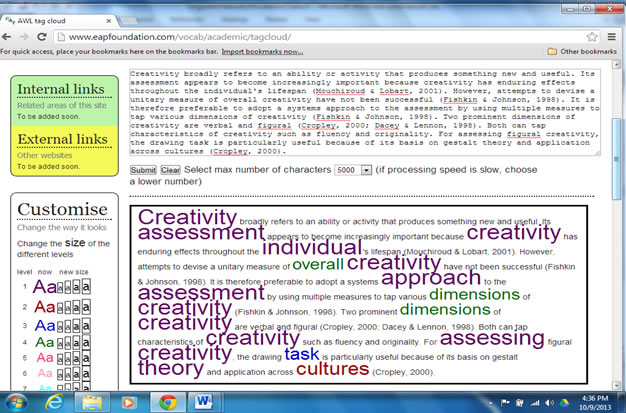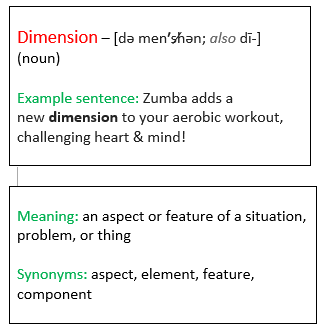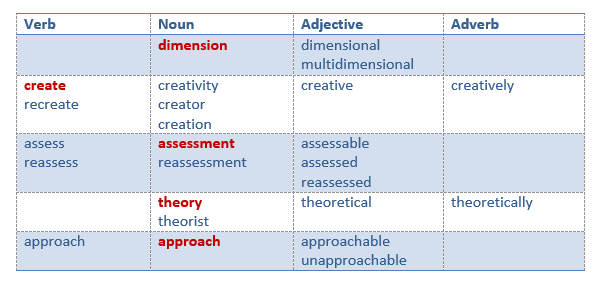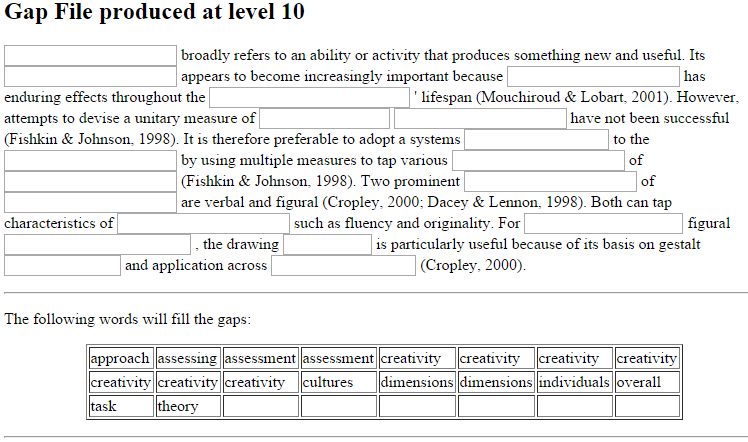
PART Three – Strategies for identifying, understanding, recording and remembering words from the Academic Word List
According to Cobb (
http://www.lextutor.ca/research/), if you know the 2000 most frequent words in written English and the 570 most frequent academic words, you will be familiar with 90% of the words that exist in any academic text.
Wow!! Isn’t that amazing? If you know nothing about these two important lists, then we recommend that you work through the activities in the set of materials entitled - Using the Academic Word List (AWL).
The Academic Word List, often shortened to simply AWL, is a list of 570 academic word families. The list was developed by Averil Coxhead at the Victoria University of Wellington, New Zealand, in the year 2000. The words selected for the AWL are ones which occur frequently in a range of academic subjects, including the Arts, Commerce, Law and the Sciences. The words are divided into 10 sublists according to their frequency; in other words, the vocabulary in Sublist 1 appears more frequently in academic writing than the vocabulary in Sublist 2. Learning these particular words will help you to:
- understand your lectures more easily
- write your assignments in an academic style
- improve your comprehension of academic texts
To access the 10 sublists go to http://www2.elc.polyu.edu.hk/cill/eap/wordlists.htm
It is important to find strategies that will help you
a) to identify the 570 words from the AWL
b) to understand the meanings of them
c) to record them in an efficient and effective way and d) to remember them so you can use them in the correct context.
Part 1Part 2Part 3Part 4
Page 1
Page 2
Page 3
Page 4
Page 5
Page 6
Rating Form
Strategy 1 - Identifying words from the AWL
There is a quick and easy way to identify which words in any text belong to the AWL. You can use an online program called the ‘AWL Highlighter’.
- Find a suitable academic text.
- Copy and paste it into the AWL highlighter progam.
- http://www.nottingham.ac.uk/alzsh3/acvocab/awlhighlighter.htm
- Select the sublist level you want to use.
- Click on submit. The program will return the text with words from the Academic Word List highlighted in bold.
Here is an example of a text you have seen earlier in this package using the ‘AWL Highlighter’ program level 10. The words highlighted in purple are all from the AWL.
| Creativity broadly refers to an ability or activity that produces something new and useful. Its assessment appears to become increasingly important because creativity has enduring effects throughout the individual's lifespan (Mouchiroud & Lobart, 2001). However, attempts to devise a unitary measure of overall creativity have not been successful (Fishkin & Johnson, 1998). It is therefore preferable to adopt a systems approach to the assessment by using multiple measures to tap various dimensions of creativity (Fishkin & Johnson, 1998). Two prominent dimensions of creativity are verbal and figural (Cropley, 2000; Dacey & Lennon, 1998). Both can tap characteristics of creativity such as fluency and originality. For assessing figural creativity, the drawing task is particularly useful because of its basis on gestalt theory and application across cultures (Cropley, 2000). |
You can also use a similar tool created by www.eapfoundation.org in which your text can be converted into a tag cloud. In the screen shot below the more common academic words from the lower-numbered sublists appear bigger than the less frequent academic words and in different colours.

| The ‘AWL Highlighter’ program is also very useful for you to check your own written assignments to see how many words from the AWL you have used. If very few words are highlighted then you know you need to work on making your own texts more academic. |
TASK 1
Now it’s your turn to use the ‘AWL Highlighter’ program. Read the article below.
Strategy 2 - Understanding the meanings of words from the Academic Word List
Once you have identified words from the AWL that are new to you,
you can make use of the many online dictionaries with their added functions to find out the meaning, other words with similar meanings, example sentences, pronunciation, etc.
Task 2
Choose one or two of the highlighted AWL words from the previous text - Afternoon naps aid children’s learning - that you don’t know the meaning of. Now try out the four different online dictionary sites below. Decide which of the sites you like and bookmark them so that you can easily access them in future. Remember, many English words have more than one meaning depending on the context, so you will need to make sure you choose the correct definition.
Site 1
Hippo http://www.wordhippo.com This site not only defines a word for you but also provides synonyms (words with similar meanings) and antonyms (words with opposite meanings). It pronounces the word for you, provides example sentences with the word in, and shows you different forms of the word.
Site Two
Your Dictionary http://www.yourdictionary.com is an online dictionary which provides definitions, sound recordings of words, synonyms and example sentences.
Site Three
Shahi http://blachan.com/shahi/ is a visual online dictionary that combines Wiktionary with Flikr.
Site Four
Snappy Words http://www.snappywords.com/ is an online interactive English dictionary and thesaurus that helps you find the meanings of words and draws connections to associated words. You can easily see the meaning of each word by simply placing your cursor over it.
If you would like to have access to more websites that offer digital tools for you to build your vocabulary go to the Learning Unlimited site at: http://www.learningunlimitedllc.com/2013/02/20-digital-tools-for-vocabulary/
Strategies for Recording Words from the Academic Word List
You have identified new academic words, checked their meaning and then what next? Hoping you will remember them by writing them down randomly on a piece of paper is not the answer. Having an effective system to record and recycle the new words is essential because only then will you remember what they mean and learn how to use them in the correct context. Here are some strategies to help you record new academic words.
Strategy 3 - Word Cards
Use note cards to record the new words. One word per note card is best. Write the new word with its pronunciation, stress and word form as well as an example sentence on one side, and the meaning and synonyms on the other side. This will allow you to test yourself by looking at the word without its definition.
Example:

Task 3
Use one of the academic words from the text - Afternoon naps’ aid children’s learning - to complete the blank cards below.



Strategy 4 - Notebooks
If you prefer to use a paper notebook, your computer, i-pad or phone you will need to think how to organize your system of recording new vocabulary.
- Alphabetically (listing words according to their first letter A, B, C etc.)
- Grammatically (listing words together according to their form e.g. nouns, verbs etc.)
- By topic (e.g. Environment, Technology, etc.)
- By frequency of use (referring to the AWL sublists, listing them under Sublist 1, Sublist 2, etc.)
- By assignment (listing words together according to the assignments you are doing for easy reference)
Strategy 5 - Word formation tables
The AWL has 570 word families. If you include all the different forms of each headword such as the nouns, verbs, adjectives and adverbs, plus the plural forms, prefixes and suffixes, that totals over 3,000 words. For the full list go to:
http://www.victoria.ac.nz/lals/resources/academicwordlist/sublists
It is therefore important to try and learn the different word forms and not just the head words from the AWL. You can do this by adding the different forms to your note cards or record book or by keeping a word form table such as the one below. The words in the table are from the AWL. The words in red are the most frequently occurring member of the word family.

Task 4
Complete the table below with words from the AWL. The words are from the text - Afternoon naps’ aid children’s learning.
Strategy 6 - Prefixes and Suffixes
Adding prefixes and suffixes to the base/root word to make new words is common in academic English. Prefixes are added in front of the base word e.g. uneconomical and suffixes to the end of the base word e.g. finalise
Task 5
Complete the sentences below with the correct prefix and/or suffix. Choose from the following examples below. You will need to change the spelling in some cases.
| -able |
un- |
-cial |
re- |
| -cant |
in- |
-al |
multi- |
Strategy 7 - Remembering words from the Academic Word List
You have identified new words from the AWL, found out what they mean, recorded them for your easy reference and now you need to remember them.
- Using and working with new words is the best way to learn and remember them. Use the new words as often as you can, not only in your written work but when speaking too.
- If you use note cards, punch a hole in the top corner and put them on a key ring. Carry them around with you. Whenever you have a few spare minutes look at your words. If possible, say them out loud and test yourself by trying to remember the meaning. Practice every day. When you are confident you have learnt a word, remove it from the key ring and add new ones.
- As you become more familiar with the words, make your own example sentences with the new word in.
- Whenever you have an assignment have your note cards or vocabulary recording device with you so that you can refer to them/it and try to include words from the AWL rather than more general words.
- You can also use the ‘AWL Gapmaker’ to create tests for yourself.
- Find a suitable academic text.
- Copy and paste it into the ‘AWL Gapmaker’ program. http://www.nottingham.ac.uk/alzsh3/acvocab/awlgapmaker.htm
- Select the sublist level you want to use.
- Click on submit. The program will replace the words from the Academic Word List with gaps.
- Fill in the gaps.
- Check your work by using the ‘AWL Highlighter’.
Here is an example of the text on Creativity using the AWL Gapmaker at level 10.
Creativity broadly refers to an ability or activity that produces something new and useful. Its assessment appears to become increasingly important because creativity has enduring effects throughout the individual's lifespan (Mouchiroud & Lobart, 2001). However, attempts to devise a unitary measure of overall creativity have not been successful (Fishkin & Johnson, 1998). It is therefore preferable to adopt a systems approach to the assessment by using multiple measures to tap various dimensions of creativity (Fishkin & Johnson, 1998). Two prominent dimensions of creativity are verbal and figural (Cropley, 2000; Dacey & Lennon, 1998). Both can tap characteristics of creativity such as fluency and originality. For assessing figural creativity, the drawing task is particularly useful because of its basis on gestalt theory and application across cultures (Cropley, 2000).

|
Task 6
Practise using the AWL Gapmaker now with an academic text of your own.
Click the tabs to show contents.








